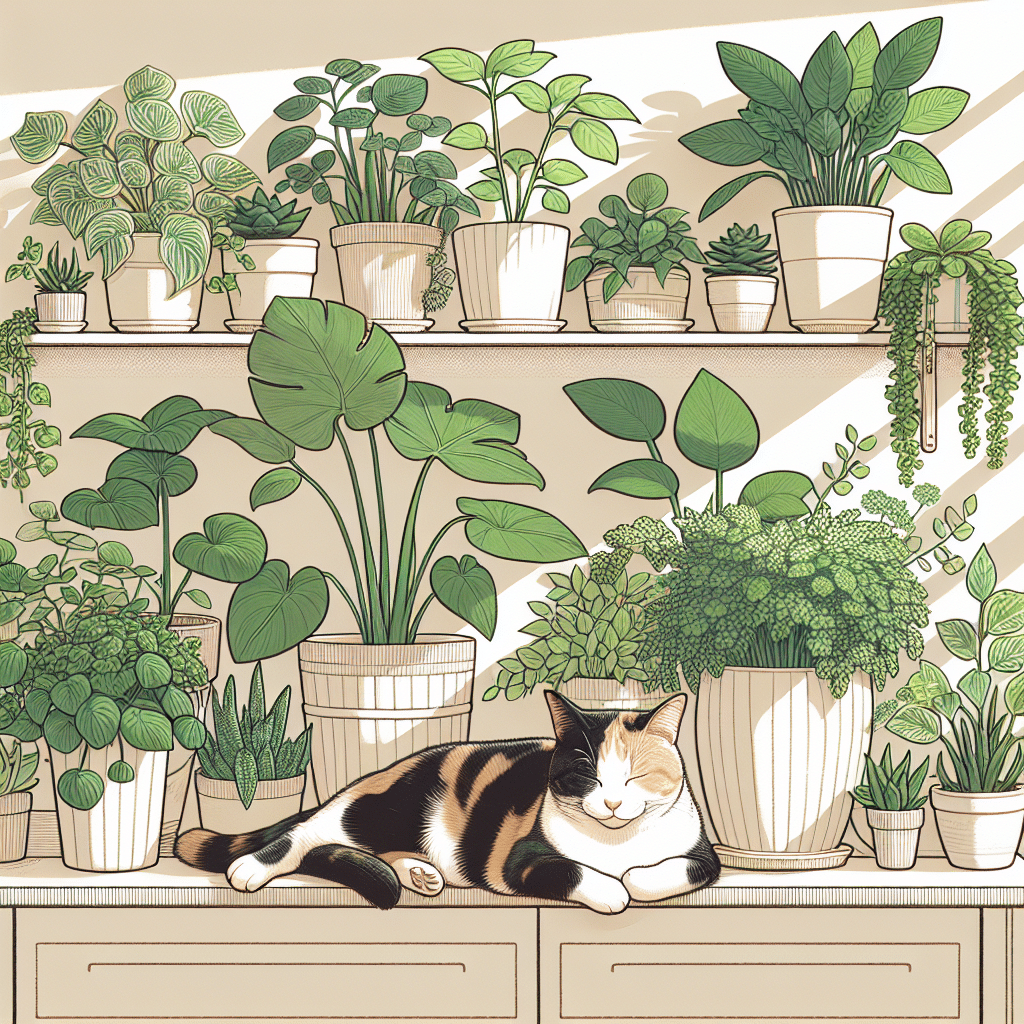Understanding Toxicity Levels in Plants
Before selecting plants for your home, it’s crucial to understand which varieties are safe for cats and which are not. The ASPCA (American Society for the Prevention of Cruelty to Animals) provides a comprehensive list of toxic and non-toxic plants. Focus on non-toxic options to ensure your feline friend remains safe.
Non-Toxic vs. Toxic Plants
- Non-Toxic Plants: These are safe for cats even if ingested, causing no adverse effects.
- Toxic Plants: These can cause illness or even be fatal if eaten. Symptoms may range from mild gastrointestinal upset to severe reactions.
Identifying Cat-Safe Indoor Plants
When you’re ready to choose cat-safe indoor plants, consider the following popular and non-toxic varieties that are aesthetically pleasing and beneficial for your home.
1. Spider Plant (Chlorophytum comosum)
- Light Requirements: Thrives in bright, indirect sunlight but can tolerate low light.
- Care: Water when the top inch of soil dries out, and keep the leaves clean of dust.
- Benefits: Excellent air purifier and easy to propagate.
2. Boston Fern (Nephrolepis exaltata)
- Light Requirements: Prefers indirect sunlight and is best in humid conditions.
- Care: Keep the soil consistently moist and mist the leaves regularly.
- Benefits: Natural air humidifier and filter.
3. Areca Palm (Dypsis lutescens)
- Light Requirements: Loves bright, indirect light but can adapt to partial shade.
- Care: Water regularly but ensure the soil dries out between watering.
- Benefits: Known for improving air quality by filtering toxins.
4. Calathea (Calathea spp.)
- Light Requirements: Prefers low to medium, indirect light.
- Care: Keep the humidity high and water when the soil begins to dry.
- Benefits: Beautiful foliage with striking patterns, adding decorative appeal.
Choosing Plants Based on Home Environment
Different plants thrive in various conditions. When selecting cat-safe indoor plants, consider your home’s lighting, humidity, and overall climate.
Bright Light Areas
- Options: Spider Plant, Areca Palm.
- Consideration: Ensure you rotate these plants to promote even growth.
Low Light Areas
- Options: Calathea, Boston Fern.
- Consideration: Use grow lights if natural light is insufficient.
High Humidity Locations (e.g., Bathrooms)
- Options: Boston Fern, Bamboo Palm (Chamaedorea).
- Consideration: Both of these plants thrive in moist environments.
Maintenance and Care Tips
To keep your indoor plants thriving and safe for your cat, proper care routines are essential.
Soil and Potting
- Use Non-Toxic Soil Mix: Ensure that your potting soil does not contain harmful additives.
- Drainage: Choose pots with drainage holes to prevent overwatering.
Regular Watering and Feeding
- Watering Schedule: Adjust according to the plant’s specific needs. Over or under-watering can harm the plant and invite pests.
- Feeding: Use organic, non-toxic fertilizers to promote healthy growth without introducing harmful substances.
Creating a Cat-Friendly Environment
Alongside cat-safe plants, consider designing a cat-friendly environment that encourages safe exploration.
Vertical Spaces
- Cat Trees: Install climbing structures that allow cats to reach higher areas without disturbing plants.
- Shelving Units: Create elevated platforms for plants out of reach of curious paws.
Plant Placement
- Strategic Positioning: Place plants in areas that are hard for your cat to reach, such as on tall shelves or hanging planters.
- Rotation: Occasionally change the arrangement to keep your cat intrigued without risking trouble.
Monitoring Plant Health and Interactions
Keep an eye on both plant health and your cat’s behavior around new plants.
Signs of Plant Distress
- Yellowing Leaves: Indicates potential overwatering or nutrient deficiencies.
- Wilting or Browning: This could signify underwatering or insect infestations.
Observing Cat Behavior
- Curiosity: Monitor how your cat interacts with new plants. If they show excessive interest, consider reinforcing boundaries.
- Health Symptoms: Watch for any signs of ingestion, such as vomiting or lethargy. If noticed, contact a vet promptly.
Educating Yourself and Family Members
Make sure all family members are informed about the plants in your home, emphasizing the importance of keeping toxic varieties out of reach.
Resources for Information
- ASPCA Plant Toxicity Database: A reliable resource for checking plant safety.
- Books and Local Events: Join local botanical gardens or workshops to learn more about plant care and safety.
Enhancing Indoor Air Quality with Safe Plants
Beyond aesthetics, cat-safe plants contribute to better indoor air quality, making your home healthier for both you and your feline companion.
Air-Purifying Properties
- Specific Plants: Plants like the Spider Plant and Areca Palm are particularly effective at eliminating pollutants.
- Psychological Benefits: Greenery can improve mental well-being and reduce stress levels.
Conclusion
Selecting cat-safe indoor plants requires research and thoughtful planning to ensure a safe and beautiful home environment. Understanding your cat’s nature, knowing plant care, and maintaining a harmonious space between greenery and feline curiosity will create a living space that nurtures both plants and pets alike. Taking these steps will help foster a serene environment where both can flourish without compromising safety.
